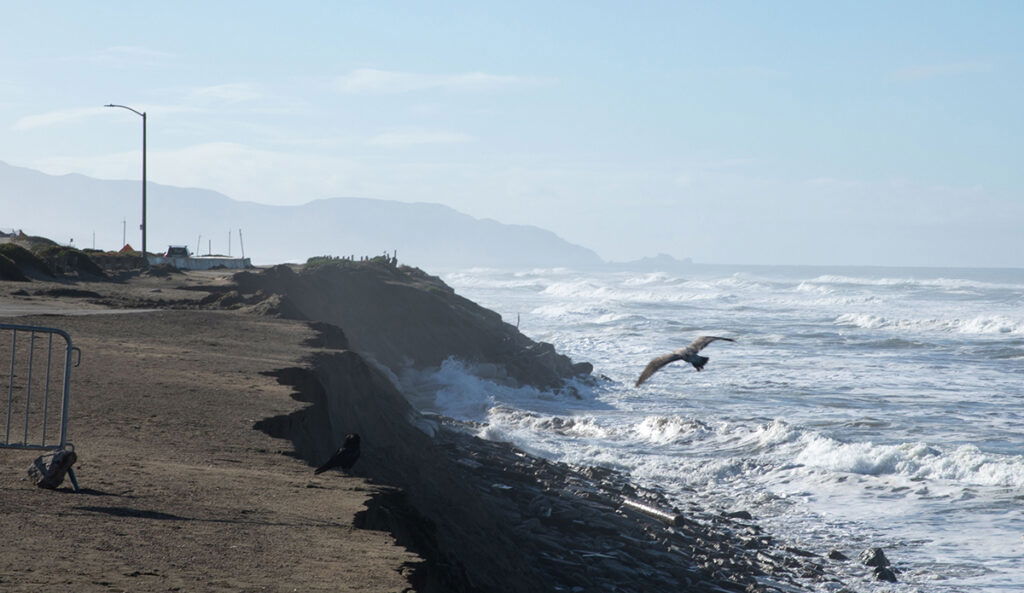Surfers Oppose New Seawall At San Francisco’s Ocean Beach
“As a surfer, I’m opposed to it. As a scientist, I’m opposed to it.”
Dubiously contracted seawalls and world-class waves go together like falcons and mice.
Last Thursday, the California Coastal Commision voted to approve a plan to build a massive 3,200-foot seawall to protect the south end of San Francisco’s Ocean Beach against erosion on Thursday.
Ocean Beach is a 3.5 mile stretch of sand, gifted a remarkable collection of sandbars by the massive flow of water in and out of the San Francisco Bay. It has hosted CT events, Stab Highway paddle challenges, and stands as the big-board-big-barrel training grounds for Northern Californians hoping to one day try their hand at Mavericks.
The seawall, designed to extend 55 feet underground, aims to protect a critical wastewater treatment facility that houses a 14-foot-diameter sewage tunnel. According to SFPUC, a failure of this tunnel could release hundreds of thousands of gallons of untreated sewage and stormwater into the ocean.
Promoted as a long-term solution for coastal management, the project seeks to combat erosion, enhance resilience to rising sea levels, and preserve public recreational access. The project also requires sand replenishment to the area in front of the seawall. Despite SFPUC’s assurances, the Surfrider Foundation has expressed doubts about the project’s effectiveness.
“We’re pretty disappointed,” said Mandy Sackett, Surfrider’s California Policy Coordinator. “I think the Coastal Commission was put in a really difficult position. But the fact is, every time a seawall is approved it increases the likelihood that more seawalls will be approved and the more we guarantee the loss of our beaches.”

According to Surfrider, the seawall is proposed to be the largest in California history.
Surfrider has stated they believe the seawall would “exacerbate erosion; which would affect the waves, the beach and beach access at Sloat as long as the seawall persists — which could be many decades. We also doubt SFPUC’s ability to keep the wall itself buried as sea levels rise. And as the wall becomes exposed, it will be an additional source of erosion in an already burdened area; accelerating the inevitable disappearance of the beach.”
“As a surfer, I’m opposed to it. As a scientist, I’m opposed to it,” coastal scientist Chase Davenport said. “It’s going to eliminate a lot of our beach. Even if the plan works like they say it would, it’s going to require an unbelievable amount of sand to cover the seawall. We don’t have that sand, (then) our beach starts to disappear,” Davenport said.
Longtime Ocean Beach Lifeguard Sean Scallan offers more context.
“It’s all kind of coming in hot and fresh right now,” Sean said. “We’re gonna learn more very quickly. It might be needed, if they do it properly, and I think properly is putting the seawall as far back as possible. If you’re getting refraction and reflection from the wall, it’s gonna take sand away from the wall, and that could just lead to more issues.
“It’s all tied into Prop K, which just passed,” continues Sean. “The city voted to close a large portion of the Great Highway so they could open a park. Most of us on the west side of the city voted ‘no’ on that whole project. It was mostly the people from the east side of San Francisco, who don’t live near the beach, that voted ‘yes’ for it. That’s all tied in together with this project, and they’re gonna need a lot more infrastructure than it looked like at first.”
In addition to the seawall, the project includes a seaside trail, a parking lot, and other features.
To learn more and to voice your opposition to the project, go to Surfrider’s website here.














Comments
Comments are a Stab Premium feature. Gotta join to talk shop.
Already a member? Sign In
Want to join? Sign Up